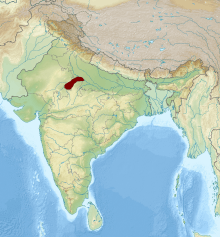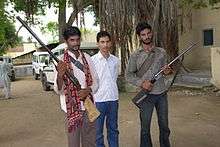Chambal (region)
The Chambal is a geographical and cultural region in north-central India. It lies along the Chambal and Yamuna river valleys, in southeastern Rajasthan, southwestern Uttar Pradesh and northern Madhya Pradesh. It is well-known for its badlands and extensive ravine systems, that have hosted an untold number of dacoits.

Geology
The Chambal badlands are part of the greater Vindhyan Basin.[1]
Geography
It covers the districts of Baran, Kota, Sawai Madhopur, Karauli, and Dholpur districts of Rajasthan, parts of Agra, Firozabad, Etawah, Auriya and Jalaun districts of UP, and Bhind, Morena and Sheopur districts of Madhya Pradesh. The region is covered by an estimated 5 Lakh hectares of badlands. It drains the northwest of the Central Vindhya Plateau and the southeastern part of the Aravalli Range. Southeastern tributaries like the Kali Sindh and Parbati begin at the extreme south of the Vindhyas and flow north in deep valleys, forming a triangular alluvial plain at elevation of 240-270 m. Afterwards the Banas, a northwestern tributary of the Chambal draining the Aravalli Range, joins the Chambal after crossing the hills near Sawai Madhopur in southeastern Rajasthan. The valley of the Chambal is wider near the confluence of the Kali Sindh and the Parbati and narrower after the confluence of the Banas. The Chambal extends to the ravines of the Choti Parbati in Rajasthan and the Kwari river in northeastern Madhya Pradesh.[1]
Culture

In the western part of the Chambal, Harauti, a Rajasthani dialect, is the main language and the region is dominated by the Meena. The eastern Chambal overlaps much with Bundelkhand, and Bundeli is the language of the area. Most people live in villages and are involved in agriculture.
The Chambal is infamous in India for its general lawlessness. The extensive systems of ravines and badlands have been home to various outlaws and dacoits for hundreds of years. Most agree that the continuing extreme poverty and slow encroachment of agricultural lands and villages by the ravine systems have caused great hardship to villagers and people. In addition, caste is still a strong identifier in the area. Dalits make up a quarter of the population, and the Sahariya tribals also are a significant group. The caste oppression done by feudal thakurs like the Rajputs and Gujjars against lower castes like Nishads and Kurmis forced many into banditry. Historically dacoits like Phoolan Devi and Man Singh gained huge followings among the people for being robin-hood figures challenging the hegemony of the landlords. To this day dacoit gangs are mostly organized along caste lines, with Rajput, Meena (Rawat), Gujjar, Kurmi, Dalit and Brahmin gangs each having followings belonging to their castes and receiving political patronage. Dacoits of one caste generally target almost exclusively other castes.[2]
References
- Sharma, Hari Shanker (1979). The Physiography of the Lower Chambal Valley and Its Agricultural Development: A Study in Applied Geomorphology. Concept Publishing Company.
- "Pursuing Dalit agenda with guns". Hindustan Times. 2006-03-31. Retrieved 2019-11-29.